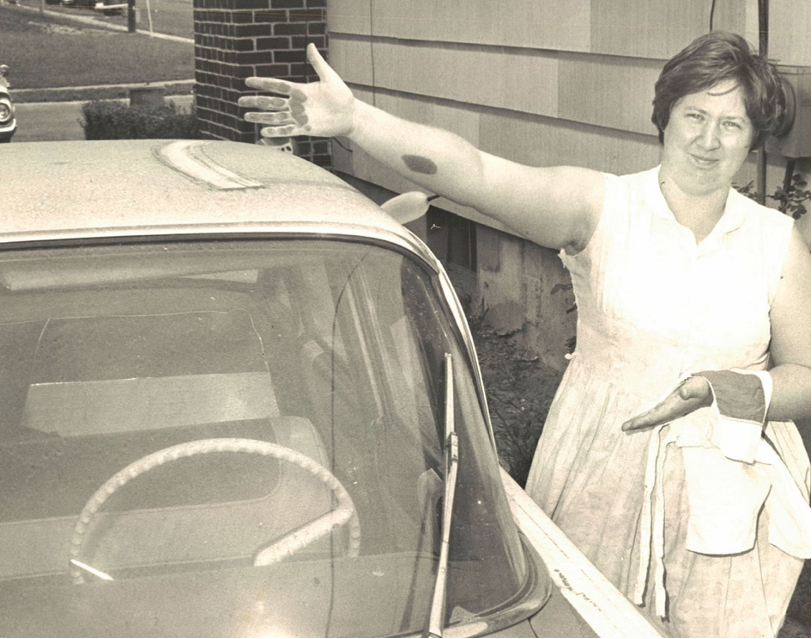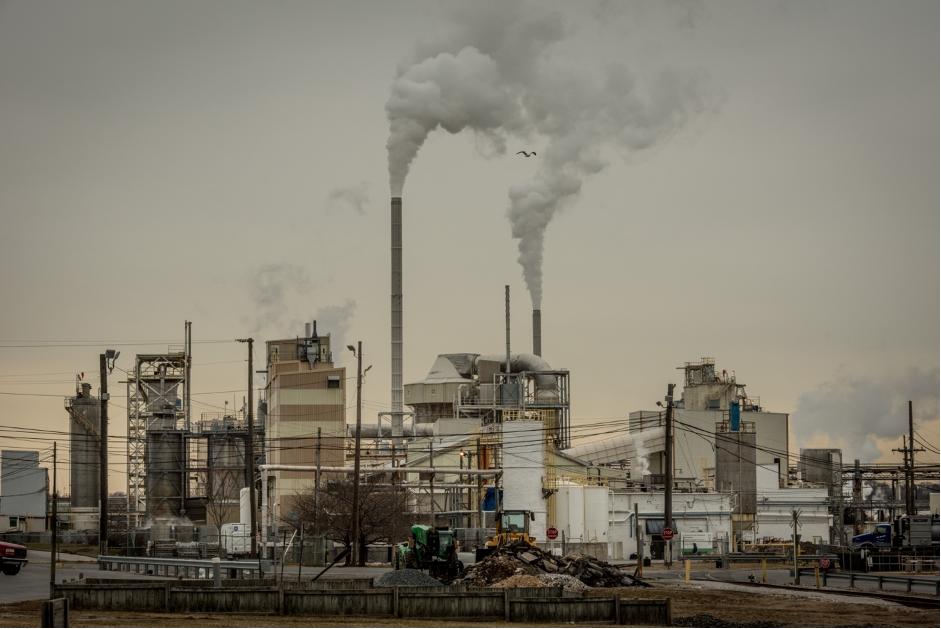Dissociation
Chloe Ahmann
It’s barely two inches thick, that door that holds her world together. She slams it shut behind me, sweeping away the dust that snuck in from a porch whose iron rails had been installed in better days. She asks how long I’ve been waiting on the filthy balcony, apologises, and then ushers me inside. Inside: where the carpet still bears imprints from the vacuum and where scented candles sit along the windowsills, releasing whiffs of ‘White Strawberry Bellini’ into the room, where they mingle with astringent cleaning sprays.
Let me tell you about the dust. The dust is one name for the enigmatic mix of dark debris that touches every surface in this corner of South Baltimore. Much of it is soot that travels from an open-air coal pier just minutes from her home. What all makes up the rest is hard to say. A short walk from that two-inch door will bring you into contact with the city’s major landfill, with the nation’s largest medical-waste incinerator, with tanker trucks that fill up at the region’s oil terminals, and with chemical plants whose owners disavow emissions1. Tiny particles escaped from these and other sources find each other somewhere between ground and sky (Choy and Zee, 2015), where the hot sun cooks them into a thick haze.
And then they settle. On cars and clotheslines, stoops and slides, kids’ bicycles. They settle on her porch, which she says she used to scrub down every day. It seemed worth it back then—when the dust anticipated money, when the money paid for iron rails, when life obeyed the forward march of Fordist rhythms—but gradually she dipped to once a week, then never. Then she quit the outdoors altogether, sealing the threshold and maintaining an inside (Roberts, 2017). Inside, she pits chemicals against chemicals to purify her home and defend against the soot that sneaks in through the cracks2. Comet. Lysol. Yankee Candles. Clorox Bleach3. These make up the haze on this side of the door: the door that cleaves uncomfortable relations.

Image 1: A Baltimore woman wipes soot from the roof of her car in a photo dated July 8, 1967, back ‘when the dust anticipated money.’ Credit: Photo from the Baltimore Sun.
We have words for splits like this in social theory—many saddled with pathologising baggage. Consider Freud’s brief musings on dissociation. In a half-written essay begun in the twilight of his life, Freud glossed what happens to the mind when confronted with dangers that imperil its integrity. One can recognise those dangers for what they are and work to deal with them, or disavow them to preserve a sense of safety. When a person takes neither path, or both at once, they inaugurate a ‘rift in the ego’ (Freud, 1938: 59): a defensive split that allows two worlds to coexist. Freud called this split ‘ingenious’, while also noting the price paid (1938: 58). As he explained in another late-stage writing, dissociation means ‘fighting on two fronts’ at once (1938: 199). One must defend her existence against an external world which threatens to undo her as well as an internal world that makes too-great demands. Anyone who wins this fight loses it just the same.
What would it mean to think dissociation as a way of managing the dizzying muddle of late industrial life? Not as a cure—at best, it produces an ‘uncomfortable comfort’ (Knight, 2021: 113)—but as a steadying mechanism that calms the vertigo brought on by heady air and lurching social change? On one level, it would mean recognising quite familiar patterns in this woman’s desperate boundary work; consider the ubiquity of gates, walls, and barriers in less extreme environments, disciplining life into an order (Pandian, 2022). The message here might be that we all dissociate sometimes, which helps us live in worlds we can’t control. Yes. But other messages lie just outside this frame.
One of them concerns the why behind this (unevenly) shared condition. If vertigo is symptomatic of structural precarities, as this collection posits, might dissociation indicate the same? Lessons along these lines begin to surface when we scale Freud’s concept up—a move I draw from Fanon’s insistence that much trauma has its roots in ‘sociogeny’ (1952: xv), and also that it preexists the patient.
So let me tell you about the dust, again. It’s not a fluke. Well before this area was an engine in the city’s waste regime and a hub of petrochemical production, it was a pastoral zone beyond the urban border where Baltimore built a quarantine station. Beginning in the 18th century, and increasingly as migrants flocked to the East Coast, officials used this place to contain contagious disease. Here, they inspected foreigners for signs of illness before their entry into Baltimore, and they carted in sick bodies from downtown to separate them from the working population. It was a foundational division—a defensive split—a spatial boundary that blurred into an epistemic one, as those who passed at quarantine could be excluded from official death counts. ‘Ingenious’. On either side of the proverbial rift, two worlds would develop in antagonistic partnership: a city under control; a periphery dissociated.
Over time, different dangers would come to threaten Baltimore’s integrity, and new barricades would reinforce the threshold. In the early 1900s, the problem was pollution, and the fix was urban land-use legislation. Quarantine rules that had pushed contagious bodies south had also driven nuisance projects here, and an industrial community was thriving by the early century—so much that Baltimore absorbed the region in an effort to expand its corporate tax base. Propping up a now-internal boundary was zoning, which carved the city into conceptually separate units and reserved this one for heavy industry. ‘Ingenious’. In the name of public health, smokestacks concentrated on this side of the divide, and locals fell away. Or rather, residential life in this place slipped into a bureaucratic blind spot (Ahmann, 2020). Also in this blind spot? Dust: implacable, inscrutable dust, growing cloudier with every generation.

Image 2: ‘Implacable, inscrutable dust’ wafts from one factory in South Baltimore. Photo taken in 2015. Credit: Photo from the Goldman Foundation.
When routed through this history, dissociation looks less like a coping mechanism left to those with little power, and more like a mode of power—even a governing logic in the urban United States. It is both symptom and syndrome; an active force behind the messes that it promises to clear; and a reminder that the muddle comes from somewhere. It should alert us to the fact that the wild, spinning vertigo at the heart of this collection is not a sign of any single person’s trauma. It names a structural condition that keeps some actors in the haze. As Kath Weston puts it in her work on making ‘visceral’ sense of damaged worlds, there is something fundamentally dissociative in the co-existence of industrialism’s ‘alienated’ commodities and the intimate exposures that it foists on many people (2017: 6). People like her, wiping surfaces on one side of the door with the very matter that she labours to keep out.
Anyone who wins this fight loses it just the same.
Endnotes
- Fortun calls disavowal a ‘key corporate tactic in late industrialism’, which turns on a ‘refusal to connect’ industrial chemicals from the harms they have produced (2014: 319) [↩]
- As Chen (2012) notes, such efforts toward purity are implicated in the making of whiteness. They embed anxieties about the incursion of impure others—toxics, people—that I observed in South Baltimore, where many insist on close ties between waste and race (Ahmann 2019). [↩]
- Here, I am drawing on Pine’s (2016) self-consciously excessive writing on the intoxicating matter of late industrial life. [↩]
References
Ahmann C (2019) Waste to Energy: Garbage Prospects and Subjunctive Politics in Late Industrial Baltimore. American Ethnologist 46(3): 328–342.
Ahmann C (2020) Toxic Disavowal. Somatosphere, January 17. Available at http://somatosphere.net/2020/toxic-disavowal.html/ (accessed 2 April 2022).
Chen MY (2012) Animacies: Biopolitics, Racial Mattering, and Queer Affect. Durham: Duke University Press.
Choy T and Zee J (2015) Condition—Suspension. Cultural Anthropology 30(2): 210–223.
Fanon F (2008 [1952]) Black Skin, White Masks. New York: Grove Press.
Fortun K (2014) From Latour to Late Industrialism. HAU 4(1): 309–29.
Freud S (1964 [1938]) An Outline of Psycho-Analysis and Splitting of the Ego in the Process of Defence. In: Strachey J (ed) The Standard Edition of the Complete Works of Sigmund Freud, Volume XXIII (1937–39). London: Hogarth Press, pp. 139–208, 271–278.
Knight DM (2021) Vertiginous Life: An Anthropology of Time and the Unforeseen. New York: Berghahn Books.
Pandian A (2022) Look Around You. The Way We Live Explains Why We Are Increasingly Polarized. The Guardian, January 16.
Pine J (2016) Last Chance Incorporated. Cultural Anthropology 31(2): 297–318.
Roberts EFS (2017) What Gets Inside: Violent Entanglements and Toxic Boundaries in Mexico City. Cultural Anthropology 32(4): 592–619.
Weston K (2017) Animate Planet: Making Visceral Sense of Living in a High-tech Ecologically Damaged World. Durham: Duke University Press.
About the author(s)
Chloe Ahmann is an Assistant Professor in the Department of Anthropology at Cornell, where she studies race, class, and environmental politics. The ideas in this piece find fuller form in her book, Futures After Progress: Living with Doubt in Late Industrial Baltimore, under contract with the University of Chicago Press. Other published work appears in venues such as Cultural Anthropology, American Ethnologist, Anthropological Quarterly, and Somatosphere (chloeahmann@cornell.edu).
For more information, visit http://www.chloeahmann.com.